Politarchopolis
Australian Capital Territory and portions of the southern highlands of NSW, Australia
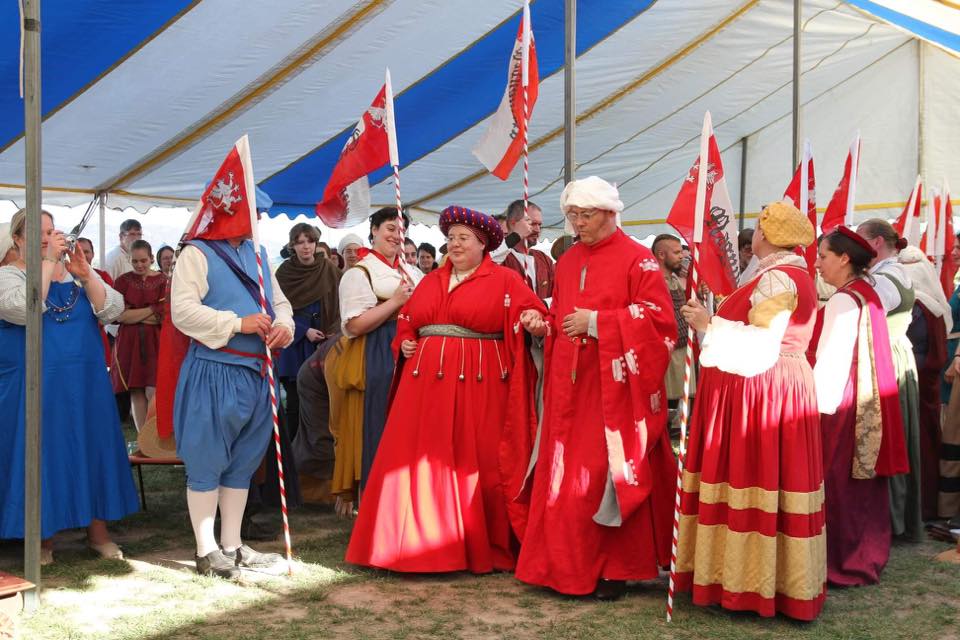 Anne and Giles, Baroness & Baron Politarchopolis
Anne and Giles, Baroness & Baron Politarchopolis
- Founded
- 1983, Agvar Guyvanaspar Seneschal
- Progress:
- Shire: January 1984; Barony: 1 July 1995 (Stephen Aldred and Mathilde Adycote of Mynheniot).
- Baronage:
- Giles Leabrook and Anne de Tournai. Full list.
- Sub-branches
- College of S. Andronicus, Cantons of Okewaite and Torlyon; College of S. Aldhelm (in abeyance); briefly College of S. Simon And S. Jude (now S. Andronicus); former proposed Canton of Isensee.
 Arms
Arms- Azure, on a fess between three laurel wreaths Or, a lymphad azure.
- Newsletter
- Griffintayle
- Internet Presence:
- Website, Facebook, Instagram, Twitter, MeetUp, Flickr
- Notable events
- Fields of Gold, St Vitus, St Valentine’s, Feast of the Four Winds
- Name origin
- Greek, “city of those who rule”; formerly Politikopolis and various other spellings
- Motto
- Ede! Ede! Nimis Macer Es! (Eat! Eat! You’re Too Thin!)
Politarchopolis is Lochac’s seventh Barony, and is based in Canberra, Australian Capital Territory, Australia.
The group was initially formed as a Shire in January 1984 (AS 18) under the name Politikopolis with Agvar Guyvanaspar as the first Seneschal. Despite being a large group for a long time, Politarchopolis resisted becoming a Barony for several years as they wanted to become a city state instead. The Shire was eventually elevated to Baronial status on 1 July 1995.

Baronial Puns
As befits a group formed by some of the first heralds of Lochac, Politarchopolis has a number of examples of wordplay in its official symbols. The name Politarchopolis is a reference to the fact that the mundane city of Canberra, the centre of the Barony, is the capital of Australia and houses all the Federal politicans on the rare occasion that they’re not off on some international junket at taxpayer expense. The device has two elements distinctive of the region – the griffin is a play on the name of Walter Burley Griffin, the architect who designed Canberra, and the red pale symbolises red tape.
Subgroups
 The Canton of Torlyon is based in the Yass, NSW region. The group was initially a Shire, however, it transferred to a Canton of Politarchopolis on 20 June 2015 at Bal d’Argent AS 50.
The Canton of Torlyon is based in the Yass, NSW region. The group was initially a Shire, however, it transferred to a Canton of Politarchopolis on 20 June 2015 at Bal d’Argent AS 50.
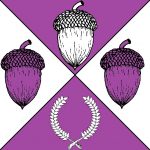 The Canton of Okewaite encompasses the Southern Highlands from Mittagong to Goulburn, New South Wales, Australia. It was originally a Canton of the Barony of Rowany, however, the group was officially transferred to Politarchopolis on 25 March 2016 at Rowany Festival AS 50.
The Canton of Okewaite encompasses the Southern Highlands from Mittagong to Goulburn, New South Wales, Australia. It was originally a Canton of the Barony of Rowany, however, the group was officially transferred to Politarchopolis on 25 March 2016 at Rowany Festival AS 50.
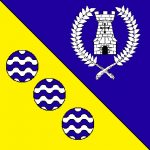 The College of St Aldhelm is based at the Australian National University, located in Acton, Australian Capital Territory, Australia. It is currently in abeyance.
The College of St Aldhelm is based at the Australian National University, located in Acton, Australian Capital Territory, Australia. It is currently in abeyance.
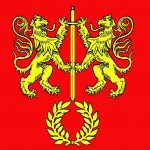 The College of Saint Andronicus is based at the University of Canberra, Belconnen, Australian Capital Territory, Australia. An earlier attempt, in 1998, to form the College of Saint Simon and Saint Jude (patron saints of lost things and lost causes) at that University fizzled after one feast; Saint Andronicus has been rather more successful than that.
The College of Saint Andronicus is based at the University of Canberra, Belconnen, Australian Capital Territory, Australia. An earlier attempt, in 1998, to form the College of Saint Simon and Saint Jude (patron saints of lost things and lost causes) at that University fizzled after one feast; Saint Andronicus has been rather more successful than that.
Baronial Awards
Baronial awards are bestowed by the landed Barons and Baronesses, often in response to recommendations they receive from the populace. Politarchopolis keeps a Roll of Arms and a Book of Ceremonies online.
The Baronial awards of Politarchopolis are as follows:
The Order of the Burly Griffin
This award was registered in 1996, and is given for excellence in service, arts and sciences, and arts martial – differentiated by the colour of the ribbon or cord from which the token is hung. The token is a pewter griffin segreant and the ribbons are white (service), green (arts and sciences) and red (arts martial).
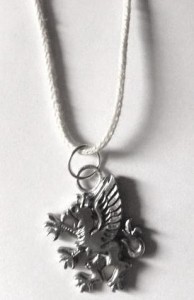
Politarchopolis Fellowship of Grace
This award is given at the Baroness’ discretion for exceptional grace, courtesy and chivalry. It is only given once a year and the token is a sun in his splendour in any medium, a symbol of Baroness Politarchopolis Mathilde whom established the award.
Order of the Cordon Rouge
The Order of the Cordon Rouge was registered in January 1996 and is the highest Baronial award of Politarchopolis. It is given by the Baron and Baroness to a person who has tied the Barony together, and is only bestowed once a year. The badge is a red mascle knot on a white field and the token can be in any medium, made by the previous recipient. In recent years, the token has been an embroidered pouch.
Order of the Griffin’s Wing
The Griffin’s Wing was registered in January 1996 and is given to those outside the Barony who have given great service to Politarchopolis. The original token was a red pouch decorated with a white wing, however, a pewter griffin’s wing suspended on a ribbon has also been used.
Order of the Griffin’s Egg
The Griffin’s Egg was registered in January 1996 and is an award given to the children of Politarchopolis for their contribution to the Barony. It is given to children under the age of 16 and may be given for many fields of endeavour – for example, enthusiasm, politeness, skill or for lending a helping hand. The token is a metal griffin hatching from an egg, suspended on a ribbon of any colour.
Pensioners
When a Baronial Guard member is stood down, they are inducted into the Pensioners of Politarchopolis. Once a year, traditionally at the Valentine’s event, the Pensioners are paid a stipend of twelve peppercorns and one gold coin (usually made of chocolate).
The payment of the Pensioners was begun by Baron and Baroness Politarchopolis as a dig at Brennan, who was very young at the time.
Baronial Huntsman
This award is given to combat archers. There is a banner, made by Lady Isabella Vitale, to which the devices of new members are added. There is also a horn, which is held by the Captain of Archers.
Free Citizens
This award is granted very rarely for an exceptional, one-time service to the Barony. Free Citizenship confers the right of free entry to Politarchopolis events for one year.
Cooks’ Favour
Politarchopolis is renowned for the excellence and generosity of her cooks. The Cooks’ Favour was made by Baroness Politarchopolis, who gave it to her Champions, each in their turn.
Signature Events
Politarchopolis’ signature events include:
Feast of Saint Valentine: Every February, Politarchopolis usually holds an event around Valentine’s day. The format varies, however, it may include a feast, a pot luck, heavy combat and/or rapier tournaments, or target archery.
Politarchopolis A&S Collegium: a relaxed weekend event of A&S classes with a feast on the Saturday night.
Politarchopolis’ Fields of Gold (FoG): The Politarchopolis’ Fields of Gold is a weekend-long event that was first held on 16-18 December 2011. It was created and stewarded by Alesia de Cheval Blanc. The event was held again on 23-25 November 2012 and 29 November to 1 December 2013. The venue for this event is the Bungendore Showgrounds in New South Wales, and it has grown to be a large event (100+ attendees) in it’s short history. This event hosts activities for equestrian, heavy combat, rapier, archery and the arts and sciences. The event is typically fully catered and includes an opulent feast on the Saturday night.
Saint Vitas: This event began as St Vitas’ Dance Weekend 1999, created by Lady Joanna of the Beechwoods as a sister event to the St Blasius Day Music Weekend. The event then consisted of 2 days of dance and dance related classes plus a Feast and a Ball somewhat casually in the style of Caroso. In 2006, when St Blasius was no-longer being held, Master Crispin Sexi convinced Joanna to include an additional stream of music classes, while she eventually convinced him to be the Steward in alternating years, and the event became St Vitas’ Dance and Music Weekend. St Vitas’ has been held every year since 1999, except 2003, the year of the Great Fire, and 2005, when the Known Worlde Dance Symposium was held in the Barony of Rowany. It is currently held in September at the Lake Tuggeranong Sea Scouts Hall.
Feast of the Four Winds: In the 1980s and early 1990s, House Smithfield held an annual feast, dedicated to producing food from at least four different areas of the known world at each feast. The last one was run by Clan Womble on behalf of House Smithfield, and cooked by Baron Bastien der Grosse. It included black pudding and eels, among other more palatable delicacies.
